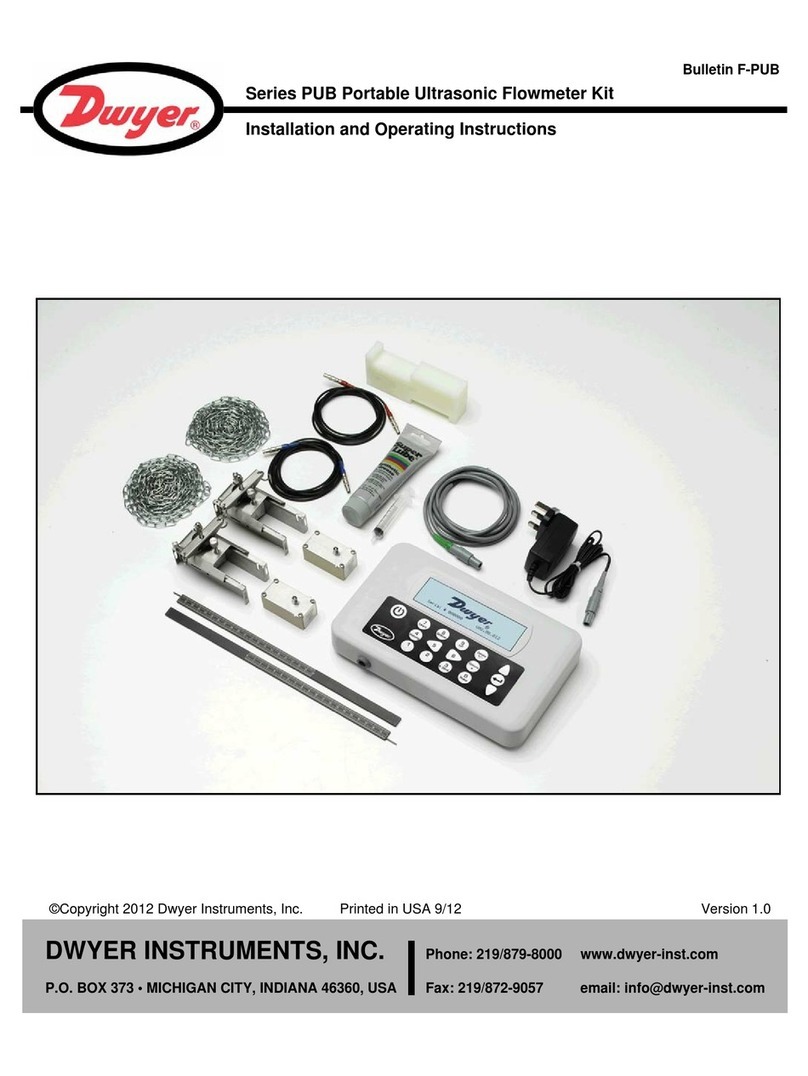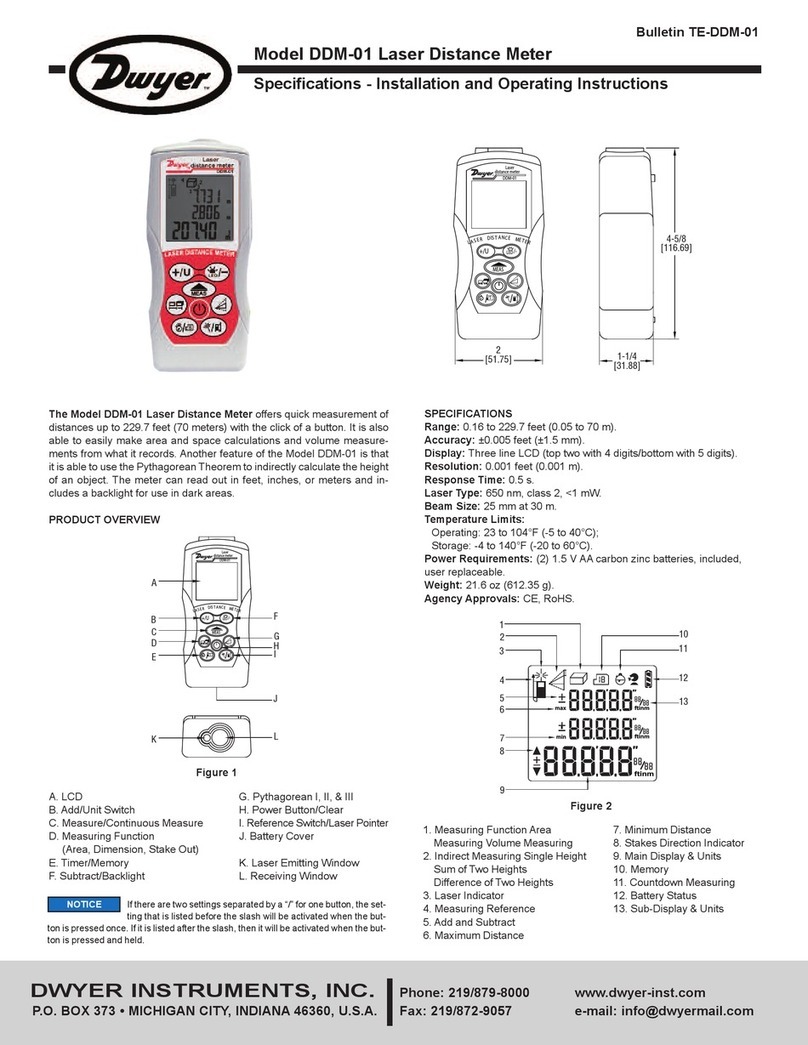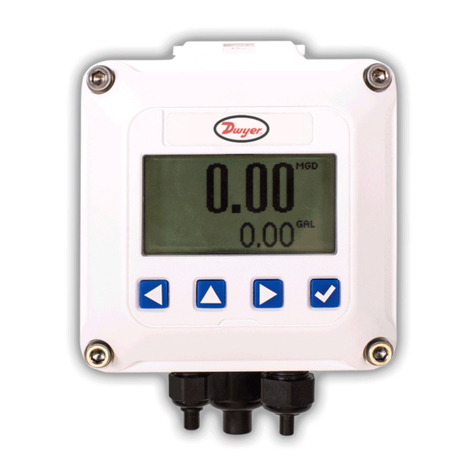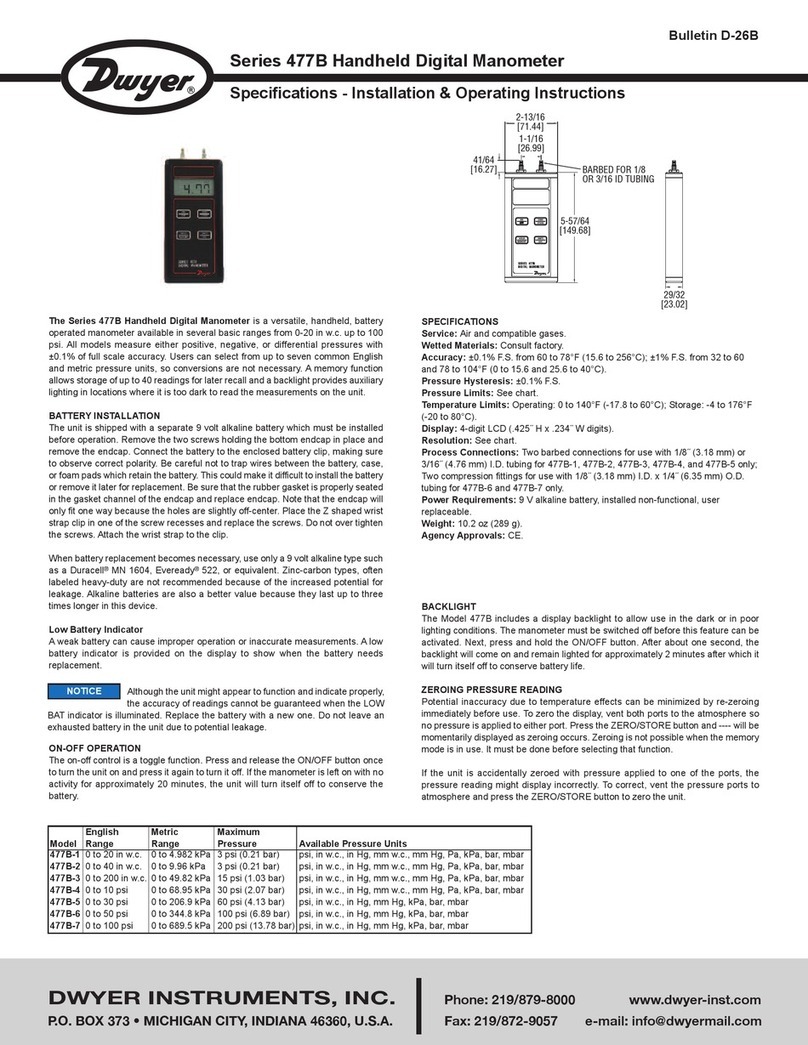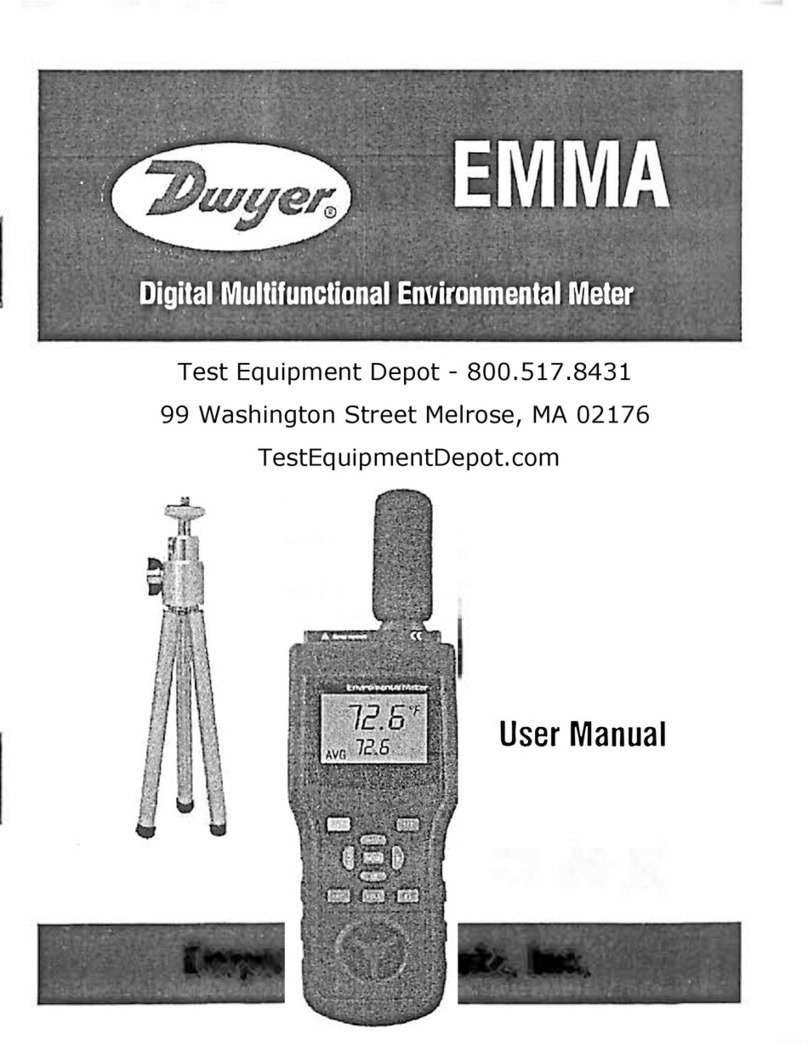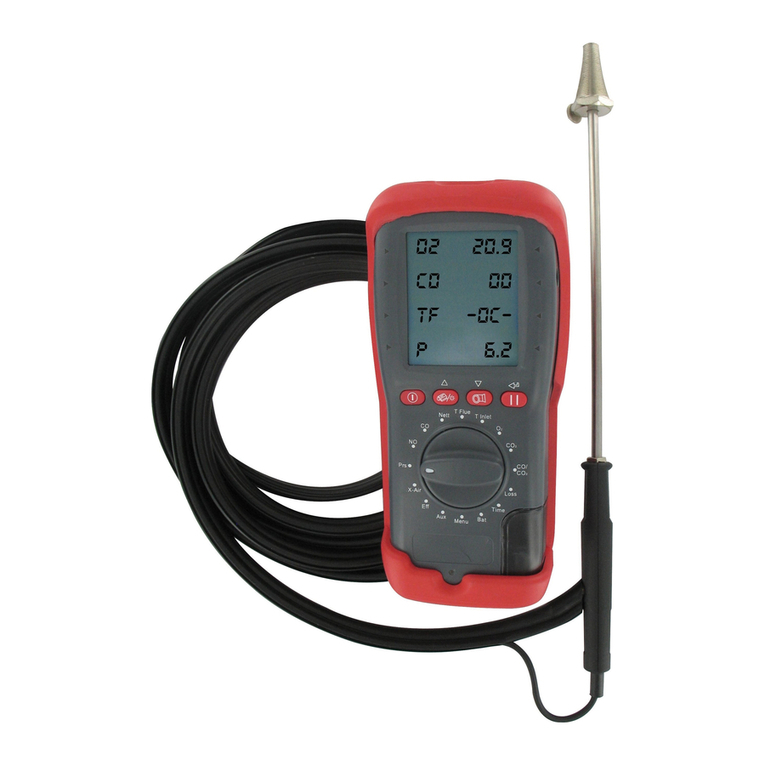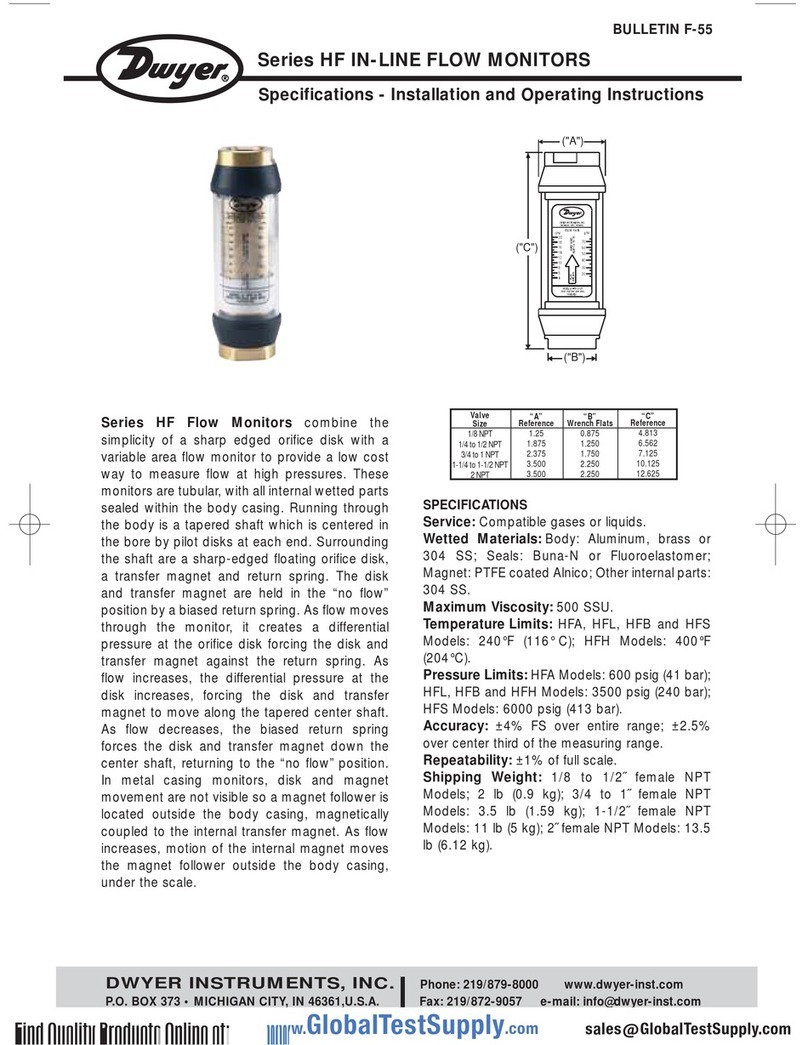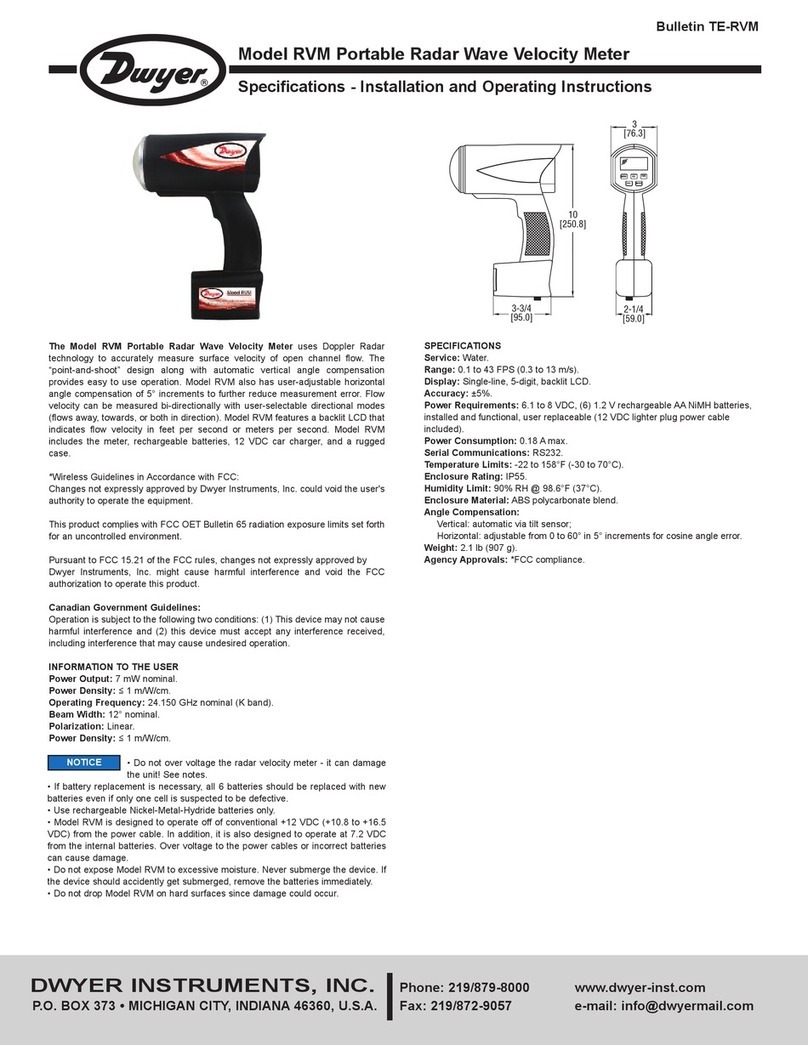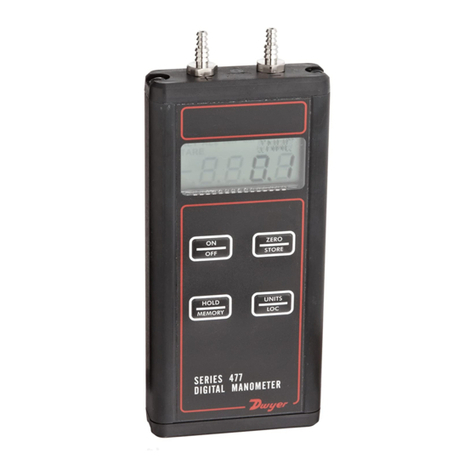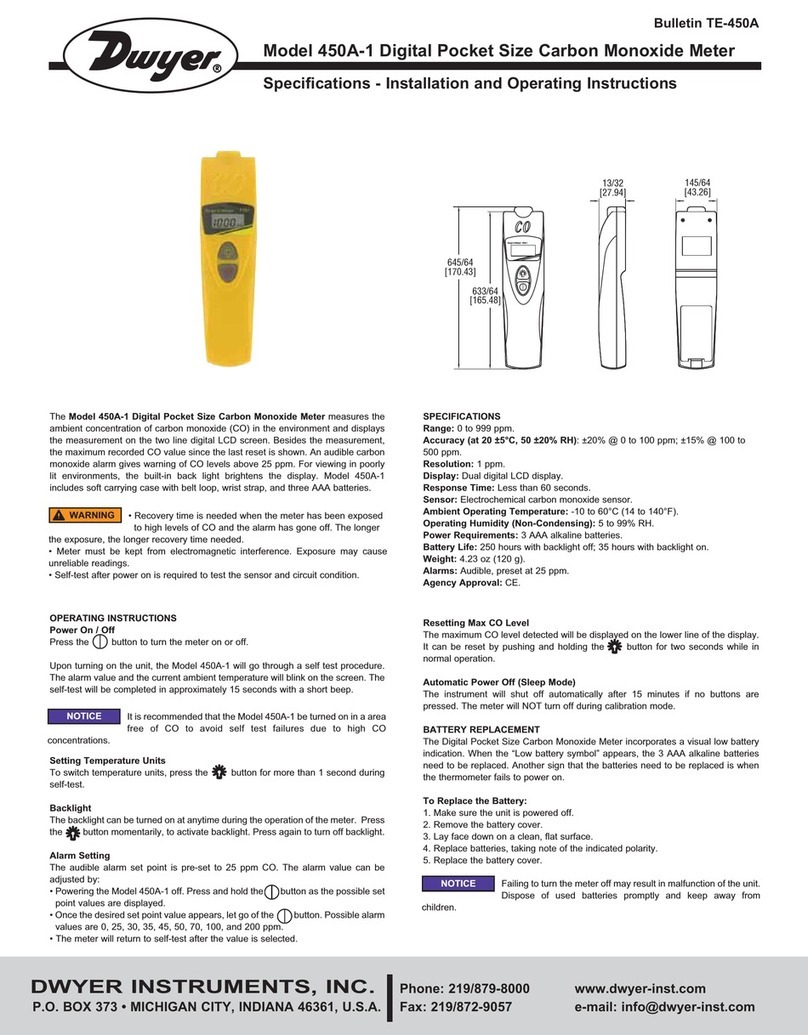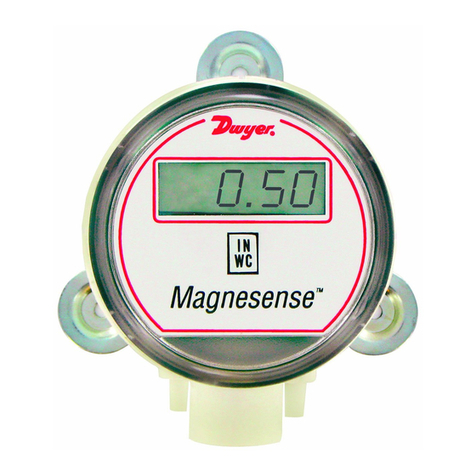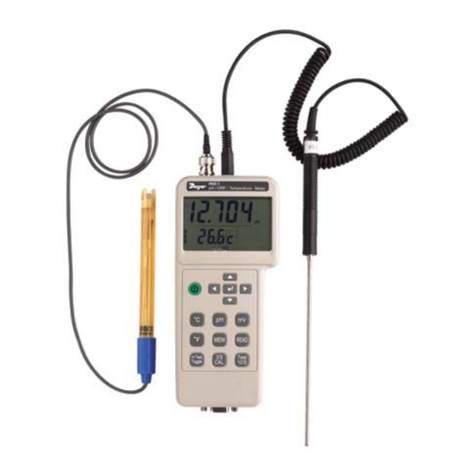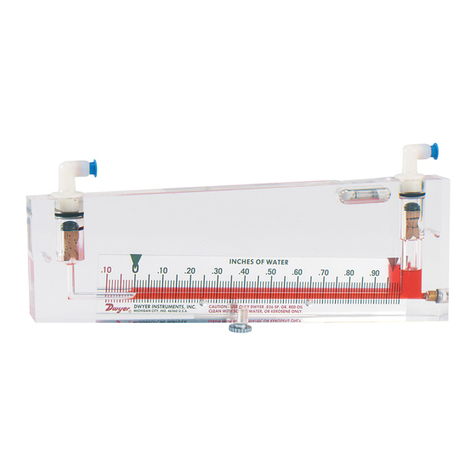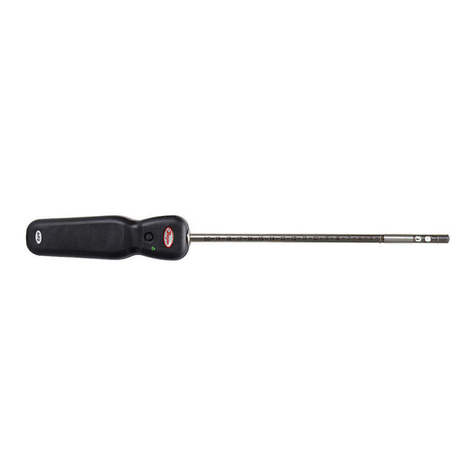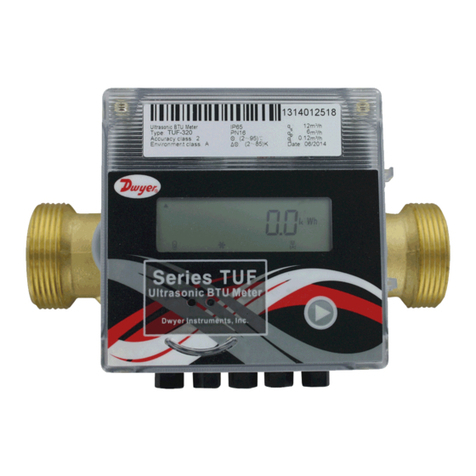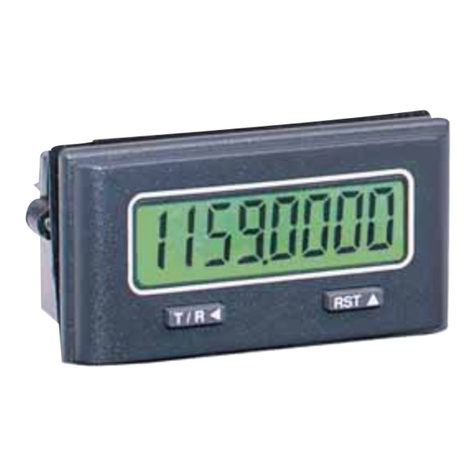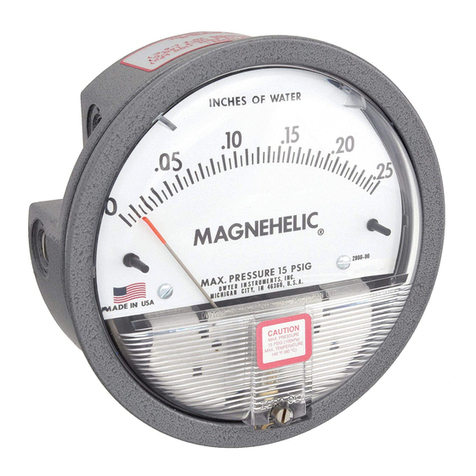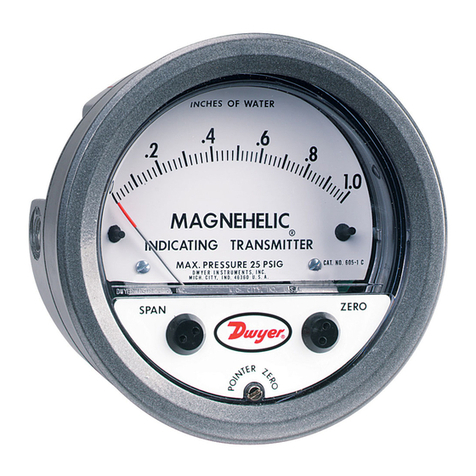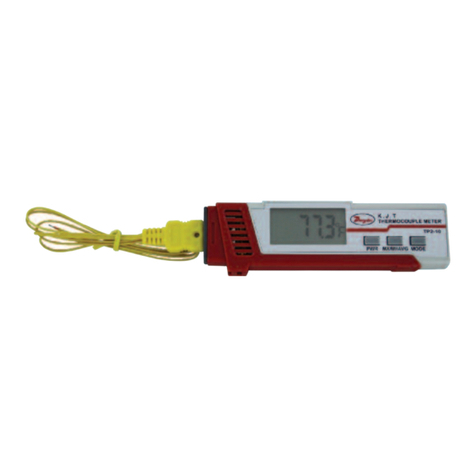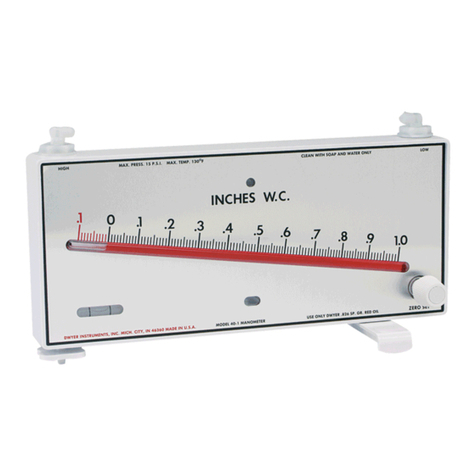
The following material is excerpted from a standard titled
Gauges-Pressure Indicating Dial Type-Elastic
Element (ANSI/ASME B40.1-1985) as published by The
American Society of Mechanical Engineers, 345 East
47th St. New York, NY 10017. This information is
furnished to assist the user of Dwyer Spirahelic®gages in
properly evaluating their suitability for the intended
application and conditions.
4 SAFETY
4.1 Scope
This Section of the Standard presents certain
information to guide users, suppliers, and manufacturers
toward minimizing the hazards that could result from
misuse or misapplication of pressure gauges with elastic
elements. The user should become familiar with all
sections of this Standard, as all aspects of safety cannot
be covered in this Section. Consult the manufacturer or
supplier for advice whenever there is uncertainty about
the safe application of a pressure gauge.
4.2 General Discussion
4.2.1 Adequate safety results from intelligent planning
and careful selection and installation of gauges into a
pressure system. The user should inform the supplier of
all conditions pertinent to the application and environment
so that the supplier can recommend the most suitable
gauge for the application.
4.2.2 The history of safety with respect to m use of
pressure gauges has been excellent. Injury to personnel
and damage to property have been minimal. In most
instances, the cause of failure has been misuse or
misapplication.
4.2.3 The pressure sensing element in most gauges is
subjected to high internal stresses, and applications exist
where the possibility of catastrophic failure is present.
Pressure regulators, chemical (diaphragm) seals,
pulsation dampers or snubbers, syphons, and other
similar items, are available for the use in these potentially
hazardous systems. The hazard potential increases at
higher operating pressure.
4.2.4 The following systems are considered potentially
hazardous and must be carefully evaluated:
(a) compressed gas systems
(b) oxygen systems
(c) systems containing hydrogen or free hydrogen
atoms
(d) corrosive fluid systems (gas and liquid)
(e) pressure systems containing any explosive or
flammable mixture or medium
(f) steam systems
(g) nonsteady pressure systems
(h) systems where high overpressure could be
accidentally applied
(i) systems wherein interchangeability of gauges could
result in hazardous internal contamination or where
lower pressure gauges could be installed in higher
pressure systems
(j) systems containing radioactive or toxic fluids
(liquids or gases)
(k) systems installed in a hazardous environment
4.2.5 When gauges are to be used in contact with
media having known or uncertain corrosive effects or
known to be radioactive, random or unique destructive
phenomena can occur. In such cases the user should
always furnish the supplier or manufacturer with
information relative to the application and solicit his advice
prior to installation of the gauge.
4.2.6 Fire and explosions within a pressure system
can cause pressure element failure with very violent
effects, even to the point of completely disintegrating or
melting the pressure gauge. Violent effects are also
produced when failure occurs due to:
(a) hydrogen enbrittlement
(b) contamination of a compressed gas
(c) formation of acetylides
(d) weakening of soft solder joints by steam or other
heat sources
(e) weakening of soft soldered or silver brazed joints
caused by heat sources such as fires
(f) corrosion
(g) fatigue
(h) mechanical shock
(i) excessive vibration
Failure in a compressed gas system can be expected to
produce violent effects.
4.2.7 Modes of Elastic Element Failure. There are
four basic modes of elastic element failure, as follows.
4.2.7.1 Fatigue Failure. Fatigue failure caused by
pressure induced stress generally occurs from the inside
to the outside along a highly stressed edge radius,
appearing as a small crack that propagates along the
edge radius. Such failures are usually more critical with
compressed gas media than with liquid media.
Fatigue cracks usually release the media fluid
slowly so case pressure buildup can be averted by
providing pressure relief openings in the gauge case.
However, in high pressure elastic elements where the
yield strength approaches the ultimate strength of the
element material, fatigue failure may resemble explosive
failure.
A restrictor placed in the gauge pressure inlet will
reduce pressure surges and restrict fluid flow into the
partially open Bourdon tube.
4.2.7.2 Overpressure Failure. Overpressure failure
is caused by the application of internal pressure greater
than the rated limits of the elastic element and can occur
when a low pressure gauge is installed in a high pressure
port of system. The effects of overpressure failure, usually
more critical in compressed gas systems than in liquid
filled systems, are unpredictable and may cause parts to
be propelled in any direction. Cases with pressure relief
openings will not always retain expelled parts.
Placing a restrictor in the pressure gauge inlet will not
reduce the immediate effect of failure, but will help control
flow of escaping fluid following rupture and reduce
potential of secondary effects.
It is generally accepted that solid front cases with
pressure relief back will reduce the possibility of parts
being projected forward in the event of failure.
The window alone will not provide adequate
protection against internal case pressure buildup, and
can be the most hazardous component.
4.2.7.3 Corrosion Failure. Corrosion failure occurs
when the elastic element has been weakened through the
attack by corrosive chemicals present in either the media
inside or the environment outside it. Failure may occur as
pinhole leakage through the elements walls or early
fatigue failure due to stress cracking brought about by
chemical deterioration or embrittlement of the material.
A chemical (diaphragm) seal should be considered for
use with pressure media that may have a corrosive effect
on the elastic element.
4.2.7.4 Explosive Failure. Explosive failure is caused
by the release of explosive energy generated by a
chemical reaction such as can result with adiabatic
compression of oxygen occurs in the presence of
hydrocarbons. It is generally accepted that there is no
known means of predicting the magnitude or effects of
this type of failure. For this mode of failure, a solid wall or
partition between the elastic element and the window will
not necessarily prevent parts being projected forward.
4.2.8 Pressure Connection. See recommendations
in paragraph 3.3.4.
4.3 Safety Recommendations.
4.3.1 Operating Pressure. The pressure gauge
selected should have a full scale pressure such that the
operating pressure occurs in the middle half (25 to 75%)
of the scale. The full scale pressure of the gauge selected
should be approximately two times the intended
operating pressure.
Should it be necessary for the operating pressure to
exceed 75% of full scale, contact the supplier for
recommendations.
This does not apply to test, retarded, or suppressed
scale gauges.
4.3.2 Use of Gauges Near Zero Pressure. The use
of gauges near zero pressure is not recommended
because the accuracy tolerance may be a large
percentage of the applied pressure. If, for example, a
0/100 psi Grade B gauge is used to measure 6 psi, the
accuracy of measurement will be ±50% of the applied
pressure. In addition, the scale of a gauge is often laid out
with takeup, which can result in further inaccuracies when
measuring pressures that are a small percentage of the
gauge span.
For the same reasons, gauges should not be used for
the purpose of indicating that the pressure in a tank,
autoclave, or other similar unit has been completely
exhausted to atmospheric pressure. Depending on the
accuracy and the span of the gauge and the possibility
that takeup is incorporated at the beginning of the scale,
hazardous pressure may remain in the tank even though
the gauge is indicating zero pressure. A venting device
must be used to completely reduce the pressure before
unlocking covers, removing fittings, or performing other
similar activities.
4.3.3 Compatibility With the Pressure Medium.
The elastic element is generally a thin walled member,
which of necessity operates under high stress conditions
and must, therefore, be carefully selected for compatibility
with the pressure medium being measured. None of the
common element materials is impervious to every type of
chemical attack. The potential for corrosive attack is
established by many factors, including the concentration,
temperature, and contamination of the medium. The user
should inform the gauge supplier of the installation
conditions so that the appropriate element materials can
be selected.
4.3.4 In addition to the factors discussed above, the
capability of a pressure element is influenced by the
design, materials, and fabrication of the joints between its
parts.
Common methods of joining are soft soldering, silver
brazing, and welding. Joints can be affected by
temperature, stress, and corrosive media. Where
application questions arise, these factors should be
considered and discussed by the user and manufacturer.
4.3.5 Some special applications require that the
pressure element assembly have a high degree of
leakage integrity. Special arrangement should be made
between manufacturer and used to assure that the
allowable leakage rate is not exceeded.
4.3.6 Cases
4.3.6.1 Cases, Solid Front. It is generally accepted
that a solid front case per para. 3.3.1 will reduce the
possibility of parts being projected forward in the event of
elastic element assembly failure. An exception is
explosive failure of the elastic element assembly.
4.3.6.2 Cases, Liquid Filled. It has been general
practice to use glycerine or silicone filling liquids.
However, these fluids may not be suitable for all
applications. They should be avoided where strong
oxidizing agents including, but not limited to, oxygen,
chlorine, nitric acid, and hydrogen peroxide are involved.
In the presence of oxidizing agents, potential hazard can
result from chemical reaction, ignition, or explosion.
Completely fluorinated or chlorinated fluids, or both, may
be more suitable for such applications.
The user shall furnish detailed information relative to
the application of gauges having liquid filled cases and
solicit the advice of the gauge supplier prior to installation.
Consideration should also be given to the
instantaneous hydraulic effect that may be created by one
of the modes of failure outlined in para. 4.2.7. The
hydraulic effect due to pressure element failure could
cause the window to be projected forward even when a
case having a solid front is employed.
4.3.7 Restrictor. Placing a restrictor between the
pressure connection and the elastic element will not
reduce the immediate effect of failure, but will help control
flow of escaping fluid following rupture and reduce the
potential of secondary effects.
4.3.8 Specific Service Conditions
4.3.8.1 Specific applications for pressure gauges
exist where hazards are known. In many instances,
requirements for design, construction, and use of gauges
for these applications are specified by state or federal
agencies or Underwriters Laboratories, Inc. Some of
these specific service gauges are listed below. The list is
not intended to include all types, and the user should
always advise the supplier of all application details.
4.3.8.2 Acetylene Gauges. A gauge designed to
indicate acetylene pressure. It shall be constructed using
materials that are compatible with commercially available
acetylene. The gauge may bear the inscription
ACETYLENE on the dial.
4.3.8.3 Ammonia Gauge. A gauge designed to
indicate ammonia pressure and to withstand the
corrosive effects of ammonia. The gauge may bear the
inscription AMMONIA on the dial. It may also include the
equivalent saturation temperature scale markings on the
dial.
4.3.8.4 Chemical Gauge. A gauge designed to
indicate the pressure of corrosive or high viscosity fluids,
or both. The primary material(s) in contact with the
pressure medium may be identified on the dial. It may be
equipped with a chemical (diaphragm) seal, pulsation
damper, or pressure relief device, or a combination. These
devices help to minimize potential damage to personnel
and property in the event of gauge failure. They may,
however, also reduce accuracy of sensitivity, or both.
4.3.8.5 Oxygen Gauge. A gauge designed to
indicate oxygen pressure. Cleanliness shall comply with
Level IV (see Section 5). The dial shall be clearly marked
with a universal symbol and/or USE NO OIL in red color
(see para. 6.1.2.1).
4.4 Reuse of Pressure Gauges
It is not recommended that pressure gauges be
moved from one application to another. Should it be
necessary, however, the following must be considered.
4.4.1 Chemical Compatibility. The consequences
of incompatibility can range from contamination to
explosive failure. For example, moving an oil service
gauge to oxygen service can result in explosive failure.
4.4.2 Partial Fatigue. The first installation may
involve pressure pulsation that has expended most of the
gauge life, resulting in early fatigue in the second
installation.
4.4.3 Corrosion. Corrosion of the pressure element
assembly in the first installation may be sufficient to cause
early failure in the second installation.
4.4.4 Other Considerations. When reusing a gauge,
all guidelines covered in the Standard relative to
application of gauges should be followed in the same
manner as when a new gauge is selected.
DWYER INSTRUMENTS, INC.
Phone: 219/879-8000 www.dwyer-inst.com
P.O. Box 373 • Michigan City, IN 46361-0373, U.S.A. Fax: 219/872-9057 e-mail: info@dwyer-inst.com
©2003 Dwyer Instruments, Inc. Printed in U.S.A. 8/03 FR# 17-440637-00 Rev. 2
REVISED A-33 8/18/03 9:56 AM Page 2
